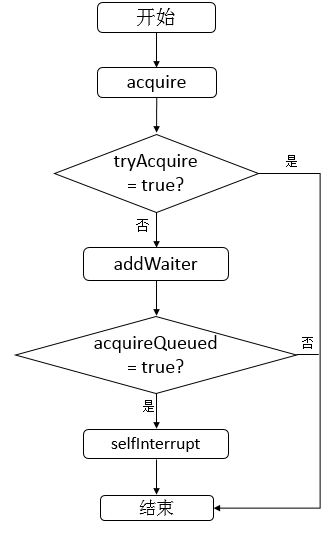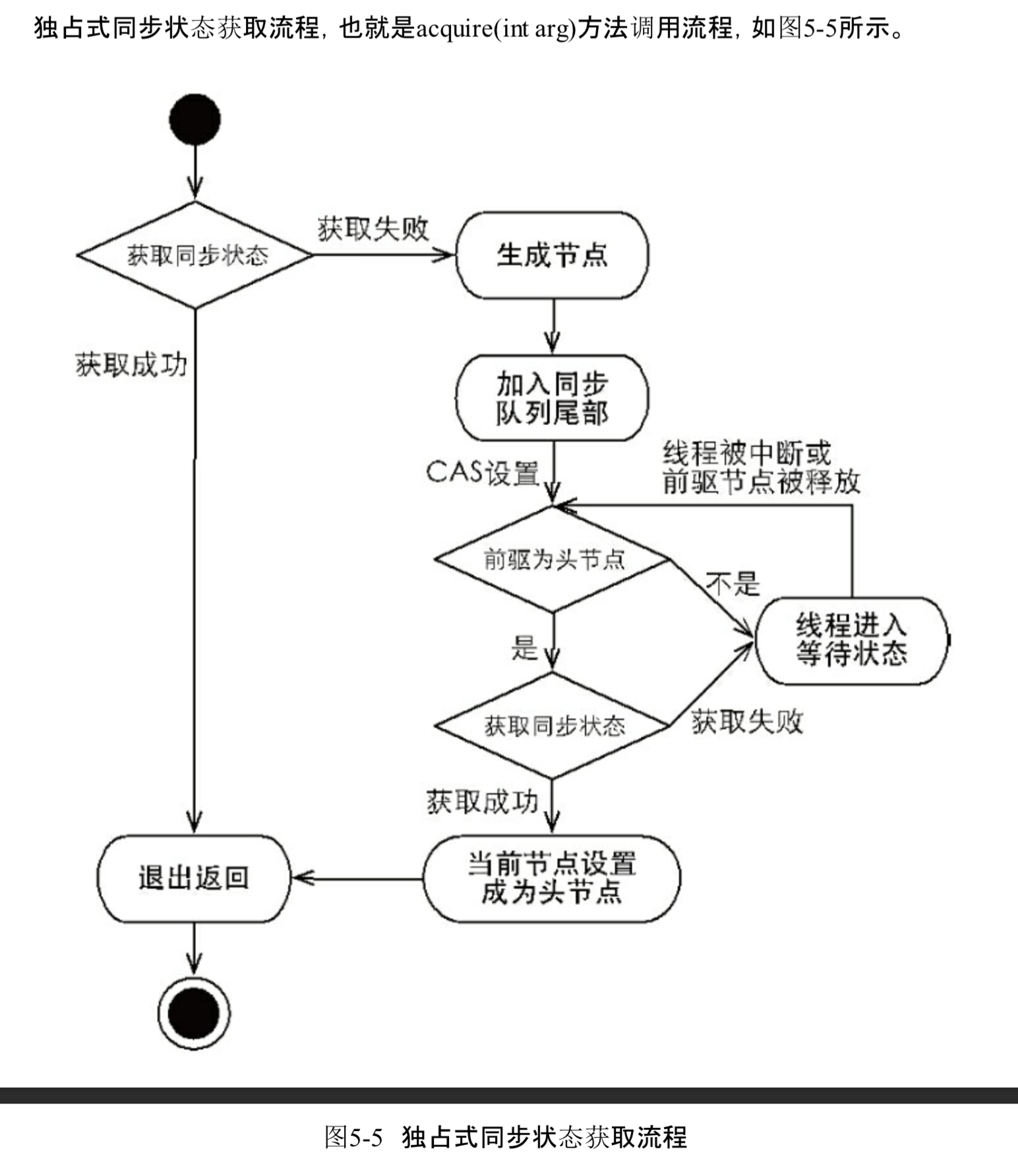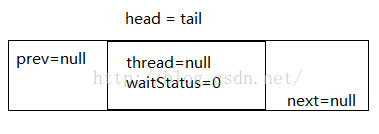简介
AbstractQueuedSynchronizer 是用来构建锁或其他同步组建的基础,在整个并发框架中占有非常重要的作用,下面我们来分析下 AbstractQueuedSynchronizer 的源码,看下它的工作原理。
AbstractQueuedSynchronizer 的主要使用方式是继承,子类通过继承 AbstractQueuedSynchronizer 并实现它的抽象方法来管理同步状态。
源码跟踪
从 ReentrantLock 的 lock() 方法开始:
public void lock() {
sync.lock();
}
它调用了 sync 的 lock() 方法。sync 在 ReentrantLock 的构造方法中创建。
/**
* Creates an instance of {@code ReentrantLock}.
* This is equivalent to using {@code ReentrantLock(false)}.
*/
public ReentrantLock() {
sync = new NonfairSync();
}
/**
* Creates an instance of {@code ReentrantLock} with the
* given fairness policy.
*
* @param fair {@code true} if this lock should use a fair ordering policy
*/
public ReentrantLock(boolean fair) {
sync = fair ? new FairSync() : new NonfairSync();
}
它分为公平锁和非公平锁两种,默认情况下是非公平锁,先看下非公平锁的 lock 方法:
/**
* Performs lock. Try immediate barge, backing up to normal
* acquire on failure.
*/
final void lock() {
if (compareAndSetState(0, 1))
setExclusiveOwnerThread(Thread.currentThread());
else
acquire(1);
}
假设这个时候还没有线程获得锁,此时第一个线程 thread1 进来尝试通过 cas 来更新 state 的值,因为没有其他线程占有锁,thread1 成功了,它得到了锁,并将 exclusiveOwnerThread 设置为当前线程。
此时来了第二个线程 thread2 ,假设 thread1 还没有释放锁,此时 CAS 获取锁会失败,然后走 acquire(1) 分支:
public final void acquire(int arg) {
if (!tryAcquire(arg) &&
acquireQueued(addWaiter(Node.EXCLUSIVE), arg))
selfInterrupt();
}
这段代码对应的图如下:


这样看起来逻辑更清晰,首先来看下 tryAcquire:
AbstractQueuedSynchronizer#tryAcquire
protected boolean tryAcquire(int arg) {
throw new UnsupportedOperationException();
}
默认抛出一个异常,由子类重写次函数来完成自己的逻辑
NonfairSync#tryAcquire:
protected final boolean tryAcquire(int acquires) {
return nonfairTryAcquire(acquires);
}
nonfairTryAcquire:
final boolean nonfairTryAcquire(int acquires) {
final Thread current = Thread.currentThread();
int c = getState();
if (c == 0) {
if (compareAndSetState(0, acquires)) {
setExclusiveOwnerThread(current);
return true;
}
}
else if (current == getExclusiveOwnerThread()) {
int nextc = c + acquires;
if (nextc < 0) // overflow
throw new Error("Maximum lock count exceeded");
setState(nextc);
return true;
}
return false;
}
一共有三个分支 如果 state 为 0 说明没有线程占有锁,此时通过 CAS 更新 state 的状态。 如果 state 不为 0 看当前线程是否是占有锁的线程,如果是 更新 state 值。 以上都不是的话 返回 false。 根据上面我们的假设,thread1 还没有释放锁,thread2 此时获取不到锁。然后进入 addWaiter
addWaiter:
private Node addWaiter(Node mode) {
Node node = new Node(mode);
for (;;) {
Node oldTail = tail;
if (oldTail != null) {
U.putObject(node, Node.PREV, oldTail);
if (compareAndSetTail(oldTail, node)) {
oldTail.next = node;
return node;
}
} else {
initializeSyncQueue();
}
}
}
很明显在 addWaiter 的内部: 首先将尝试获取锁的线程也就是 thread2 封装为一个 Node 对象,并且我们知道在当前执行环境下线程队列是空的,所以直接进入 initializeSyncQueue 方法:
/**
* Initializes head and tail fields on first contention.
*/
private final void initializeSyncQueue() {
Node h;
if (U.compareAndSwapObject(this, HEAD, null, (h = new Node())))
tail = h;
}
此方法创建了一个空的节点,并通过 CAS 将此节点赋值给 head 节点,然后 tail 节点也指向此节点,此时的节点状态如下:

然后返回 addWaiter 函数,此时 oldTail 不是 null了,然后做了以下两个操作:
1、 将刚才传递进来的 node 的前驱节点设置为 oldTail。
此时结构如下:

2、 通过 CAS 操作,将我们传递进来的 node 设置为 tail 节点,并将之前尾节点的 next 指向传递进来的 node 节点。此时结构如下:

这个时候代码中出现了 return 关键字,也就是通过两次循环跳出了这个自旋体系。
按照代码执行流程,接下来会执行 acquireQueued 方法。现在我们来看下 acquireQueued 方法,它内部也是一个自旋循环:
final boolean acquireQueued(final Node node, int arg) {
try {
boolean interrupted = false;
for (;;) {
final Node p = node.predecessor();
if (p == head && tryAcquire(arg)) {
setHead(node);
p.next = null; // help GC
return interrupted;
}
if (shouldParkAfterFailedAcquire(p, node) &&
parkAndCheckInterrupt())
interrupted = true;
}
} catch (Throwable t) {
cancelAcquire(node);
throw t;
}
}
首先会获取当前节点的前驱节点,判断它是不是头节点,现在我们的状态是:

和明显当前 node 节点的前驱节点是 head 节点,然后再次尝试获得锁,此时 thread1 还没有释放锁,获取失败,然后会进入 shouldParkAfterFailedAcquire 方法:
private static boolean shouldParkAfterFailedAcquire(Node pred, Node node) {
int ws = pred.waitStatus;
if (ws == Node.SIGNAL)
/*
* This node has already set status asking a release
* to signal it, so it can safely park.
*/
return true;
if (ws > 0) {
/*
* Predecessor was cancelled. Skip over predecessors and
* indicate retry.
*/
do {
node.prev = pred = pred.prev;
} while (pred.waitStatus > 0);
pred.next = node;
} else {
/*
* waitStatus must be 0 or PROPAGATE. Indicate that we
* need a signal, but don't park yet. Caller will need to
* retry to make sure it cannot acquire before parking.
*/
pred.compareAndSetWaitStatus(ws, Node.SIGNAL);
}
return false;
}
-
如果前驱节点的waitStatus为-1,也就是SIGNAL,就返回true。
-
如果当前节点的前驱节点的waitstatus大于0,也就是说被CANCEL掉了,这时候通过 do while 循环去除 waitstatus 大于 0 的节点。
-
如果都不是以上的情况,就通过CAS操作将这个前驱节点设置成SIGHNAL。
很明显,我们在这里的情况是第3种情况,并且这个方法运行后返回false。
此时的结构如下,主要是head节点的waitStatus由0变成了-1。

第二次循环依然会尝试获得锁,此时 thread1 还没有释放,依然失败。然后再次进入 shouldParkAfterFailedAcquire 方法,检查前驱节点的额 waitstatus。此时 waitstatus 为 -1 返回 true。然后调用 parkAndCheckInterrupt 方法,直接将当前线程 thread2 禁止:
private final boolean parkAndCheckInterrupt() {
LockSupport.park(this);
return Thread.interrupted();
}
假设现在 thread1 还没有释放锁,然后又来了一个线程 thread3,然后一路再走到 acqureQueued 时,第一次循环判断 node 的前驱节点是否是 head 节点,现在我们的状态是:

node 节点的前驱节点不是 head 节点,走第二个 if 分支,调用 shouldParkAfterFailedAcquire 方法。
-
如果前驱节点的waitStatus为-1,也就是SIGNAL,就返回true。
-
如果当前节点的前驱节点的waitstatus大于0,也就是说被CANCEL掉了,这个时候我们会除掉这个节点。
-
如果都不是以上的情况,就通过CAS操作将这个前驱节点设置成SIGHNAL。
很明显,我们在这里的情况是第3种情况,并且这个方法运行后返回false。
此时的结构如下,主要是t节点的waitStatus由0变成了-1。

然后第二次循环,将 thread3 也挂起。
锁的释放过程
现在 thread1 要释放锁了,调用 unlock 方法,unlock 又调用了内部的 release 方法:
public final boolean release(int arg) {
if (tryRelease(arg)) {
Node h = head;
if (h != null && h.waitStatus != 0)
unparkSuccessor(h);
return true;
}
return false;
}
tryRelease:
protected final boolean tryRelease(int releases) {
int c = getState() - releases;
if (Thread.currentThread() != getExclusiveOwnerThread())
throw new IllegalMonitorStateException();
boolean free = false;
if (c == 0) {
free = true;
setExclusiveOwnerThread(null);
}
setState(c);
return free;
}
获取当前AQS的state,并减去1,判断当前线程是否等于AQS的exclusiveOwnerThread,如果不是,就抛异常,这就保证了加锁和释放锁必须是同一个线程。如果(state-1)的结果不为0,说明锁被重入了,需要多次unlock。如果(state-1)等于0,我们就将AQS的ExclusiveOwnerThread设置为null。如果上述操作成功了,也就是tryRelase方法返回了true,那么就会判断当前队列中的head节点,当前结构如下:

如果head节点不为null,并且head节点的waitStatus不为0, 我们就调用unparkSuccessor方法去唤醒head节点的后继节点。
private void unparkSuccessor(Node node) {
/*
* If status is negative (i.e., possibly needing signal) try
* to clear in anticipation of signalling. It is OK if this
* fails or if status is changed by waiting thread.
*/
int ws = node.waitStatus;
if (ws < 0)
node.compareAndSetWaitStatus(ws, 0);
/*
* Thread to unpark is held in successor, which is normally
* just the next node. But if cancelled or apparently null,
* traverse backwards from tail to find the actual
* non-cancelled successor.
*/
Node s = node.next;
if (s == null || s.waitStatus > 0) {
s = null;
for (Node p = tail; p != node && p != null; p = p.prev)
if (p.waitStatus <= 0)
s = p;
}
if (s != null)
LockSupport.unpark(s.thread);
}
第一步:获取head节点的waitStatus,如果小于0,就通过CAS操作将head节点的waitStatus修改为0,现在是:

第二步:寻找head节点的下一个节点,如果这个节点的waitStatus小于0,就唤醒这个节点,否则遍历下去,找到第一个waitStatus<=0的节点,并唤醒。现在thread2线程被唤醒了,我们知道刚才thread2在acquireQueued被中断,现在继续执行,又进入了for循环,当前节点的前驱节点是head并且调用tryAquire方法获得锁并且成功。那么设置当前Node为head节点,将里面的thead和prev设置为null。
final boolean acquireQueued(final Node node, int arg) {
try {
boolean interrupted = false;
for (;;) {
final Node p = node.predecessor();
if (p == head && tryAcquire(arg)) {
setHead(node);
p.next = null; // help GC
return interrupted;
}
if (shouldParkAfterFailedAcquire(p, node) &&
parkAndCheckInterrupt())
interrupted = true;
}
} catch (Throwable t) {
cancelAcquire(node);
throw t;
}
}

调用完毕后,acquireQueued返回false。并且现在thread2自由了。 以上是 NonfairSync 的获取和释放锁的流程。下面看一下 FairSync 的获取锁的代码:
/**
* Fair version of tryAcquire. Don't grant access unless
* recursive call or no waiters or is first.
*/
protected final boolean tryAcquire(int acquires) {
final Thread current = Thread.currentThread();
int c = getState();
if (c == 0) {
if (!hasQueuedPredecessors() &&
compareAndSetState(0, acquires)) {
setExclusiveOwnerThread(current);
return true;
}
}
else if (current == getExclusiveOwnerThread()) {
int nextc = c + acquires;
if (nextc < 0)
throw new Error("Maximum lock count exceeded");
setState(nextc);
return true;
}
return false;
}
FairSync 的 tryAcquire 方法在尝试获取锁的时候先判断等待队列里是否有节点,以实现公平。